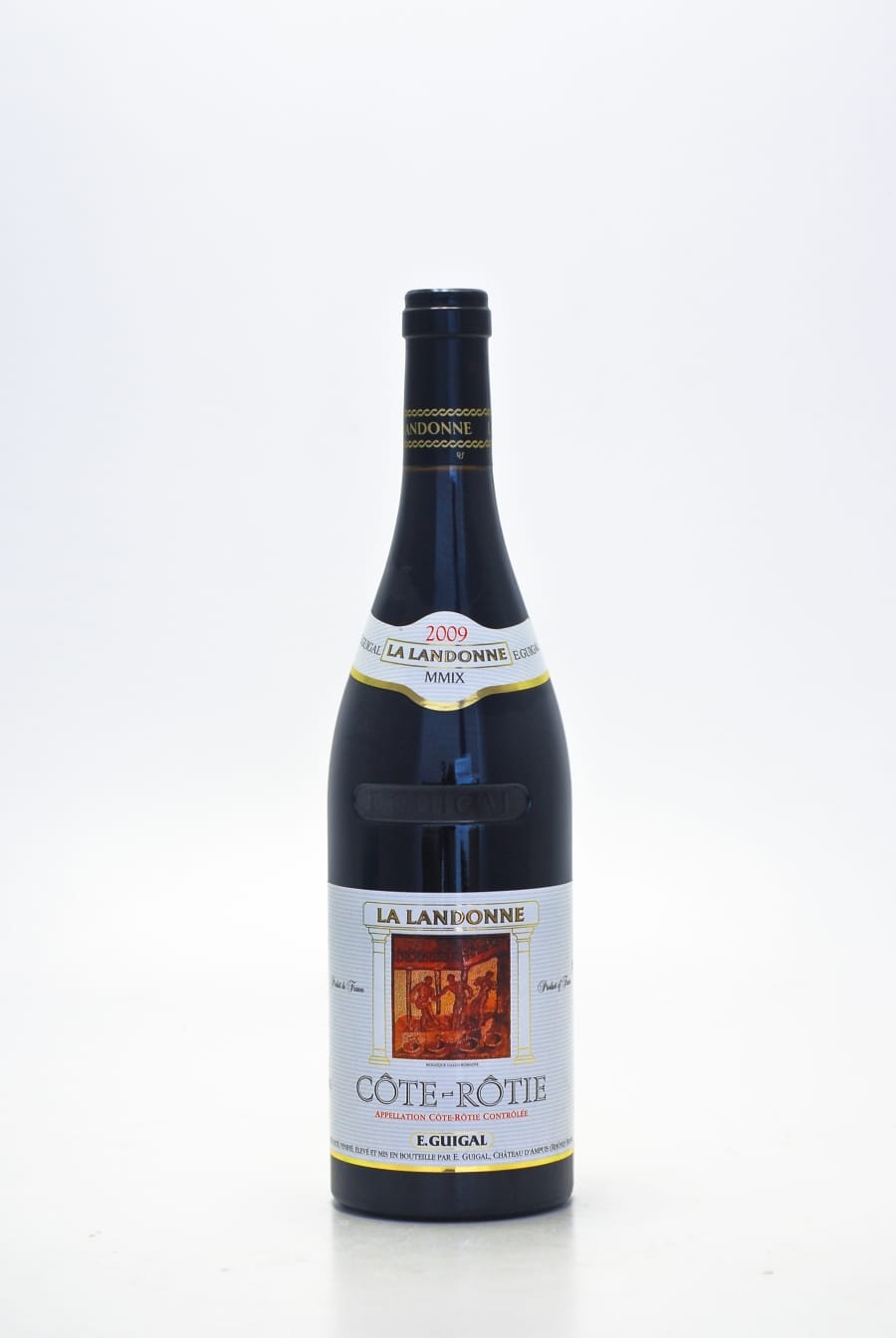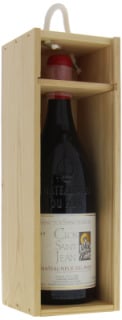Cote Roti La Landonne 2009 Guigal
| Classification | |
| Type | Rouge |
| Marque | Guigal |
| Millésime | 2009 |
| Pays | France |
| Région | Rhone |
| Volume | |
| État | Extrait de son coffret en bois d'origine |
| Étiquette | Parfait |
| Stock | 0 |
Avis professionnels
Robert Parker (100)
The 2009 Cote Rotie La Landonne is a killer wine. An extravagant bouquet of black truffles, roasted meats, licorice, ground pepper, blackberries, scorched earth and camphor soars from this muscular, dense, over-the-top, serious, masculine La Landonne. Built like Arnold Schwarzenegger was two decades ago, this enormously concentrated bodybuilder of a wine should hit its prime in a decade, and last 40-50 years. This is no trivial boast as the debut vintage of La Landonne, the 1978, is just reaching full maturity at age 34.
The Guigal family may be the modern world’s greatest testament to a family-run winery with impeccably high standards, integrity and an uncompromising vision of the future. They continue to push the envelope of quality to greater and greater heights. Marcel Guigal learned it all from his father, Etienne, a legend in the Northern Rhone. Over my three decade plus career, it has been a noteworthy story to watch Marcel’s son, Philippe, take full responsibility for the future direction of this incredible enterprise, if not empire. I have almost unlimited admiration for the Guigals and their ability to produce millions of bottles of inexpensive Cotes du Rhones that are among the finest of the entire Rhone Valley, as well as their portfolio of exquisite whites, reds and roses from the most prestigious appellations in the Rhone. After more than three decades of tasting here, I never cease to be amazed by what they accomplish. I have said this many, many times, but it bears repeating – the magic of the Guigals is not only due to having some extraordinary vineyards in St.-Joseph, Hermitage, Cote Rotie and Condrieu, but also the ability to pay the highest price for purchased grapes and/or wine from which they fashion remarkable blends. The importance of a wine’s upbringing (or, as the French call it, elevage) is the key to understanding the entire Guigal locomotive. No one does it better; no one has done it longer; and no one seems to have the Midas touch for putting the wines in the bottle at precisely the right moment to capture the essence of a wine before it begins to fade or lose its vibrancy. This may sound easy, but to date, no one comes remotely close to what the Guigals consistently do across all fields of play. About a decade ago, Guigal’s white wines began to take on an amazing level of quality and the family continues to augment and increase that quality. Their Cotes du Rhone Blanc, usually a blend of two-thirds Viognier and the rest Clairette and Bourboulenc, has become a reference point for what amazing value and high quality can be achieved in a completely naked, expressive wine. Guigal produces approximately 40% of all the Condrieu made, and he continues to add some exquisite terroirs to his portfolio. For example, he recently bought the vineyard owned by Alain Parent and Gerard Depardieu, Lys de Volant. Guigal can produce two cuvees of white Hermitage, their regular blend of 90% Marsanne and 10% Roussanne, and, in exceptional vintages, a luxury cuvee called Ex-Voto, which is approximately 80% Marsanne and 20% Roussanne. It spends more time in small new oak than the regular cuvee. From the Northern Rhone, Guigal’s finest values are his Crozes-Hermitage and his lower level cuvees of St.-Joseph, all of which are 100% Syrah. The Crozes-Hermitage comes from hillside vineyards and the St.-Joseph comes from hillsides with decomposed granite soils that are commonplace in the northern half of that sprawling appellation. With the purchase of the estates of Jean-Louis Grippat as well as the holdings of De Vallouit, Guigal increased his estate vineyards in Hermitage. A basic Hermitage cuvee is produced each year, and in the top vintages, a luxury cuvee called Ex-Voto is made. Guigal now owns vineyards in the famed lieux-dits of Les Bessards, Dionnieres, l’Ermite and Le Meal. The regular Hermitage is generally aged for up to three years in small oak casks, about 50% new. When declared, the Ex-Voto is given the same 42 months in 100% new French oak as his three single vineyard Cote Roties (La Mouline, La Landonne and La Turque). The Ex-Voto is a blend of fruit from Les Bessards (40%), Les Greffieux (40%) and Les Murets (20%). Guigal produces approximately 300,000 bottles each year of his Cote Rotie Brune et Blonde. We started with the 2008, probably the second worst vintage in the Northern Rhone (2002 being the worst in the last decade). Not a single vineyard wine, but a prodigious Cote Rotie is Guigal’s Cote Rotie Chateau d’Ampuis. Marcel Guigal’s son, Philippe, lives at this estate with his wife and children, and this is also where they cooper their wood barrels made from staves that are air-dried a minimum of three years. This cuvee is always a blend of some of the finest parcels on the hillsides of Cote Rotie, including La Garde, Le Clos, Grande-Plantee, Pommiere, Pavillon, Le Moulin and La Viria. It is aged 38 months in 100% new French oak, and around 2,000 cases are produced in most vintages. The three single vineyard Cote Roties are consistently among the world’s greatest wines. I often find La Mouline to be a so-called “desert island” wine as it was in vintages such as 1978, 1983, 1985, 1988, 1989, 1991, 1999, 2003, 2005 and 2009. La Mouline is made from the oldest vines and is vinified differently than the other single vineyard cuvees, utilizing pump-over techniques as opposed to punching down (La Turque) or immersed cap (La Landonne). To reiterate, the Cote Rotie La Turque comes from the Cote Brune and its upbringing is the same as La Mouline’s, aged 42 months in 100% new French oak, co-fermented with 5-7% Viognier, and bottled unfined and unfiltered. It comes from younger vines as the first vintage was 1985 and that remarkable wine was made from 3-year-old vines (which puts a kink in the French myth that old vines are always the best). As I previously indicated, La Turque is vinified by punching down as opposed to pumping over or the immersed cap fermentation of La Landonne. The third of these prodigious Cote Roties, La Landonne, comes from the Cote Brune. Unlike its siblings, it is 100% Syrah that receives the same upbringing, 42 months in 100% new French oak and bottling with no fining or filtration. The other luxury cuvee, although not a single vineyard wine, is the Hermitage Ex-Voto, which is aged 42 months in 100% new oak and bottled unfined and unfiltered. It is always fashioned from Les Bessards (40%), Les Greffieux (40%), Les Murets (10%) and l’Ermite (10%). The Gigondas and Chateauneuf du Pape produced by Guigal are often excellent, even outstanding wines that sell for a fraction of the price asked for his luxury cuvees of Cote Rotie, Hermitage, Condrieu and St.-Joseph. Guigal’s Gigondas spends around 24-25 months in wood foudres, and includes a great deal of Mourvedre in the blend. The Chateauneuf du Pape, which comes from purchased wine, is aged two years in foudre prior to release. Guigal normally includes a minimum of 10% Mourvedre in the blend, with the balance old vine Grenache. As I have said many times, one of these days the Guigals will purchase a famous estate in Chateauneuf du Pape because Marcel’s father, Etienne, had always said the three greatest appellations of the Rhone Valley were Cote Rotie, Hermitage and Chateauneuf du Pape (few people would disagree).
Winespectator (99)
This delivers a stunningly ripe, pure, polished bolt of plum confiture, along with notes of anise, mocha, blueberry coulis, Black Forest cake and espresso. The finish sports admirable grip for this ripe-styled vintage, with a grounding rod of iron buried deeply. There's fruit and muscle now, with minerality to burn while this is cellared.






























